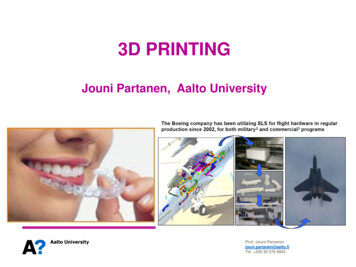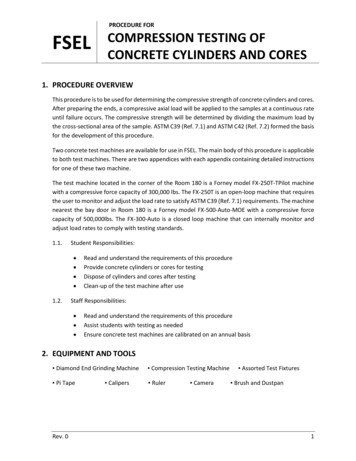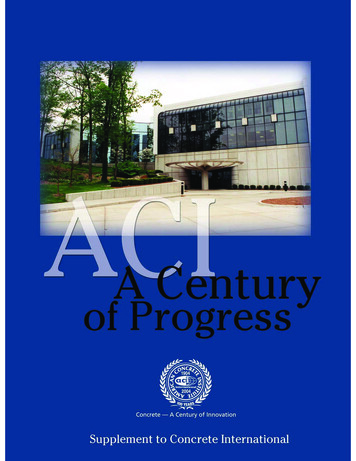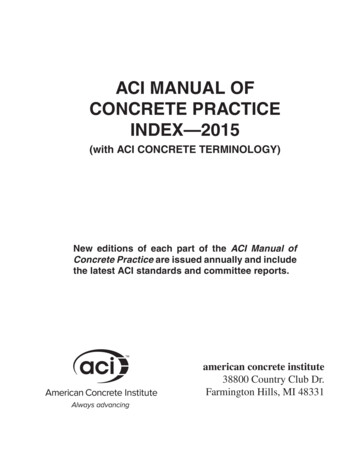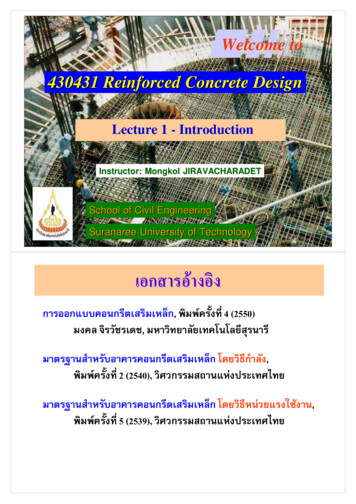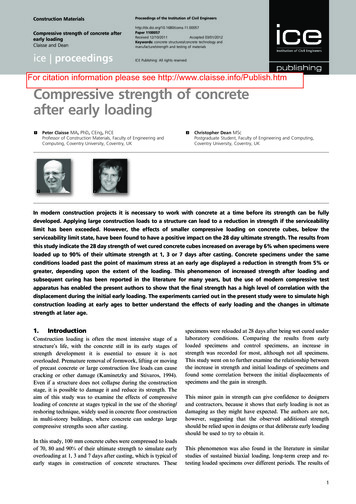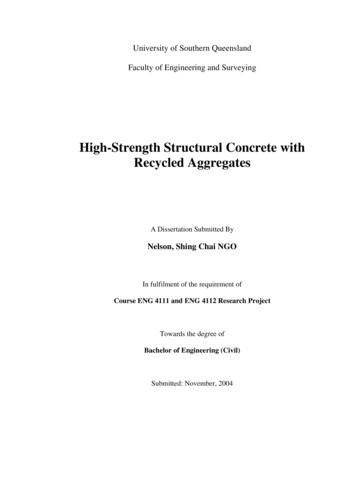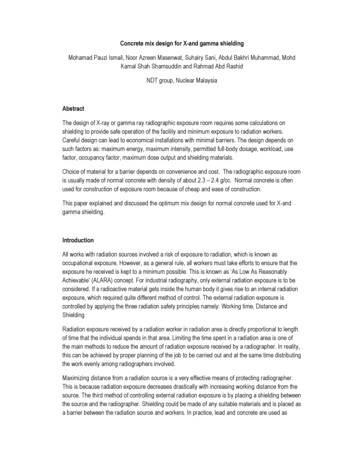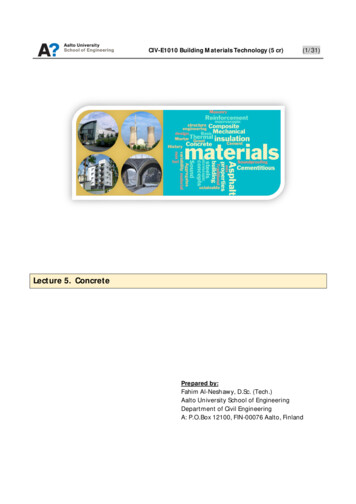
Transcription
CIV-E1010 Building Materials Technology (5 cr)(1/31)Lecture 5. ConcretePrepared by:Fahim Al-Neshawy, D.Sc. (Tech.)Aalto University School of EngineeringDepartment of Civil EngineeringA: P.O.Box 12100, FIN-00076 Aalto, Finland
CIV-E1010 Building Materials Technology (5 cr)(2/31)Table of ContentsLecture 5.5.1Concrete. 1Basic ingredients of concrete . 35.1.1Cement. 35.1.2Aggregate . 35.1.3Water . 55.1.4Concrete admixtures. 55.2Concrete mix design procedure (Nykänen method) . 75.2.1Specified concrete properties . 75.2.2Procedure for concrete mix design . 95.3Batching and mixing of concrete . 155.3.1Batching of concrete ingredients . 155.3.2Concrete mixers . 155.3.3Mixing of concrete . 165.3.4Ready-Mixed Concrete (RMC) . 175.4Properties of fresh concrete . 195.4.1Workability . 195.4.2Setting time of concrete . 245.4.3Air content . 255.5Properties of hardened concrete. 265.5.1Strength of concrete . 265.5.2Creep of concrete . 275.5.3Durability of concrete . 285.5.4Shrinkage in Concrete . 285.5.5Modulus of Elasticity . 295.5.6Water tightness (impermeability) of concrete. 295.6Advantages and disadvantages of reinforced concrete . 30
CIV-E1010 Building Materials Technology (5 cr)(3/31)5.1 Basic ingredients of concreteConcrete is a mixture of cement, water, fine aggregate (sand) and coarse aggregate (gravel orcrushed rocks) in which the cement and water have hardened by a chemical reaction – hydration – tobind the nearly (non - reacting) aggregate.Figure 1.Basic ingredients of concreteThe importance of the ingredients should be known before there are used in cement concrete.5.1.1CementCement is binding material in the cement concrete. This concrete is used for different engineeringworks where strength and durability are of prime importance.Functions of cement: 5.1.2It fills up voids existing in the fine aggregate and makes the concrete impermeable.It provides strength to concrete on setting and hardening.It binds the aggregate into a solid mass by virtue of its setting and hardening properties whenmixed with water.AggregateAggregates are used in two size groups to provide good quality of concrete: Fine aggregate (sand) particle size less than 4.75mmCoarse aggregate – Particle size more than 4.75mm
CIV-E1010 Building Materials Technology (5 cr)(4/31)Fine aggregate (sand):Sand consists of small angular or rounded grains of silica. Sand is commonly used as the fineaggregate in cement concrete. Both natural and artificial sands are used for this purpose.Functions of sand:1. It fills the voids existing in the coarse aggregate.2. It reduces shrinkage and cracking of concrete.3. By varying the proportion of sand concrete can be prepared economically for anyrequired strength4. It helps in hardening of cement by allowing the water through its voids.5. To form hard mass of silicates as it is believed that some chemical reaction takes placebetween silica of sand and constituents of cement.Requirements:1.2.3.4.5.6.Fine aggregate should consist of coarse angular sharp and hard grains.It must be free from coatings of clay and silt.It should not contain any organic matter.It should be free from hygroscopic salt.It should be strong and durable and chemical inert.The size of sand grains should pass through 4.75mm sieve and should be entirelyretained on 75 micron sieve.Coarse aggregate:Functions of coarse aggregates:1. Coarse aggregate makes solid and hard mass of concrete with cement and sand.2. It increases the crushing strength of concrete.3. It reduces the cost of concrete, since it occupies major volume.Requirements:1. Coarse aggregate used may be crushed stone, gravel and broken bricks.2. Crushed stone: It is an excellent coarse aggregate provided. It is obtained by crushinggranite, sandstone and close grained limestone.3. Crushed granite chips are commonly and advantageously used in reinforced cementconcrete.4. Broken bricks well burnt and over burnt bricks are broken into suitable size and used asaggregate. It should be well watered before its use. Broken bricks are used asaggregate for concrete in foundations and under floors.5. But generally crushed stone is only used as coarse aggregate.
CIV-E1010 Building Materials Technology (5 cr)5.1.3(5/31)WaterThe water is used in concrete plays an important part in the mixing, laying compaction setting andhardening of concrete. The strength of concrete directly depends on the quantity and quality of wateris used in the mix.Functions of water:1. Water is only the ingredient that reacts chemically with cement and thus setting andhardening takes place.2. Water acts as a lubricant for the aggregate and makes the concrete workable.3. It facilitates the spreading of cement over the fine aggregate.5.1.4Concrete admixturesConcrete admixtures are added to change the properties of concrete to make it function as required.Admixtures are used to modify properties of both fresh and hardened concrete as discussed below:Functions of admixtures to modify fresh concrete properties:a) To increase workability without increasing water content or to decrease the water content atthe same workability.b) To retard or accelerate both initial and final setting times.c) To reduce or prevent settlement.d) To create slight expansion in concrete and mortar.e) To modify the rate or capacity for bleeding or both.f) To reduce segregation of concrete, mortars and grouts.g) To improve penetration and or pumpability of concrete, mortars and grouts.h) To reduce rate of slump loss.Functions of admixtures to modify hardened concrete properties:a)b)c)d)e)f)g)h)i)j)k)To retard or reduce heat generation during early hardening.To accelerate the rate of strength development.To increase the strength of concrete or mortar (Compressive, tensile or flexural).To increase the durability or resistance to severe conditions of exposure including theapplication de-icing salts.To decrease the capillary flow of water.To decrease the permeability to liquids.To control the expansion caused by the reaction of alkalis with certain aggregate constituents.To produce cellular concrete.To increase the bond of concrete to steel reinforcement.To increase the bond between old and new concrete.To improve impact resistance and abrasion resistance.
CIV-E1010 Building Materials Technology (5 cr)(6/31)l) To inhibit the corrosion of embedded metal.m) To produce coloured concrete or mortar.The classification of concrete admixtures is presented as follow:1. Set-Retarding:Set retarding concrete admixtures are used to delay the chemical reaction that takes place when theconcrete starts the setting process.2. Air-Entrainment:Air entrained concrete can increase the freeze-thaw durability of concrete. Other benefits from thisadmixture are: High resistance to cycles of wetting and dryingHigh degree of workabilityHigh degree of durabilityThe entrained air bubbles act as a physical buffer against the cracking caused by the stresses due towater volume augmentation in freezing temperatures. Air entrainers are compatible with almost allthe concrete admixtures. Typically for every 1% of entrained air, compressive strength will be reducedby about 5%.3. Water-Reducing:Water-reducing admixtures are chemical products that when added to concrete can create a desiredslump at a lower water cement ration than what is normally designed. Water-reducing admixtures areused to obtain specific concrete strength using lower cement content.4. Accelerating:Accelerating concrete admixtures are used to increase the rate of concrete strength development, orto reduce concrete setting time. Calcium chloride could be names as the most common acceleratorcomponent; however, it could promote corrosion activity of steel reinforcement. Acceleratingadmixtures are especially useful for modifying the properties of concrete in cold weather.5. Shrinkage Reducing:Shrinkage reducing concrete admixtures are added to concrete during initial mixing. This type ofadmixture could reduce early and long term drying shrinkage.6. Super plasticizers:The main purpose of using super plasticizers is to produce flowing concrete with very high slump inthe range of 200 - 250 mm to be used in heavily reinforced structures and in placements whereadequate consolidation by vibration cannot be readily achieved. The other major application is theproduction of high-strength concrete at w/c's ranging from 0.3 to 0.4. High workability concrete
CIV-E1010 Building Materials Technology (5 cr)(7/31)containing super plasticizer can be made with a high freeze-thaw resistance, but air content must beincreased relative to concrete without super plasticizer.7. Corrosion-Inhibiting:Corrosion-inhibiting admixtures fall into the specialty admixture category and are used to slowcorrosion of reinforcing steel in concrete. Corrosion inhibitors can significantly reduce maintenancecosts of reinforced concrete structures throughout a typical service life of 30 – 40 years.5.2 Concrete mix design procedure (Nykänen method)Mix design is the process of selecting the proportions of cement, water, fine and coarse aggregatesand, if they are to be used, additions and admixtures to produce an economical concrete mix with therequired fresh and hardened properties.Nykänen method (1): 5.2.1Developed by professor Arvo Nykänen (1912 – 1990)1st version of the proportion method was developed in 1945 and the publications about themethod during the years 1947 and 1948The new version of the methods established in 1955 because of the changes in the code ofpractices and the development of concrete technologySpecified concrete propertiesA properly proportioned concrete mix should possess the following qualities:i.ii.iii.Acceptable workability of the freshly mixed concreteDurability, strength, and uniform appearance of the hardened concrete à result from thestructural design processEconomy.The requirement (input) for the Nykänen method are: 1The 28 days compressive strength of the concrete (nominal strength)The slump of the fresh concrete mass (workability), shown in Table 1.The 28 days compressive strength of the cement usedThe air-content of concrete (generally assumed 2% for normal concrete)The grading and the moisture content of the aggregatesThe amount of absorbing water in the aggregates (generally estimated to be 0.4 %)Any other information about the concrete structureArvo Nykänen, talven taitaja ja suhteituksen isä. Online at kanentalven-taitaja-ja-suhteituksen-isa
CIV-E1010 Building Materials Technology (5 cr)(8/31)Table 1. The permissible slump for various types of concrete in relation to their use2Concrete structuresReinforced foundation walls and footingsPlain footings, caissons and substructure wallsSlabs, beams, thin reinforced walls and building columnsPavements and floor laid on groundHeavy mass construction2Consistency (Slump), [mm]MaximumMinimum12550100251507575257525ACI 211.1 - 91 (Reapproved 2009), “Standard Practice for Selecting Proportions for Normal, Heavy weight, and MassConcrete”, specifically Chapter 6, “Procedure” and Appendix 1, “Metric (SI) System Adaptation. Online crete mix design guide.pdf
CIV-E1010 Building Materials Technology (5 c
But generally crushed stone is only used as coarse aggregate. CIV-E1010 Building Materials Technology (5 cr) (5/31) 5.1.3 Water The water is used in concrete plays an important part in the mixing, laying compaction setting and hardening of concrete. The strength of concrete directly depends on the quantity and quality of water is used in the mix. Functions of water: 1. Water is only the .
